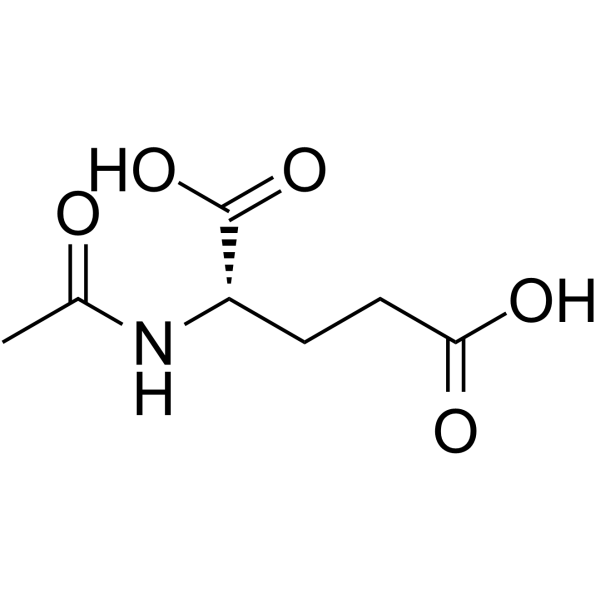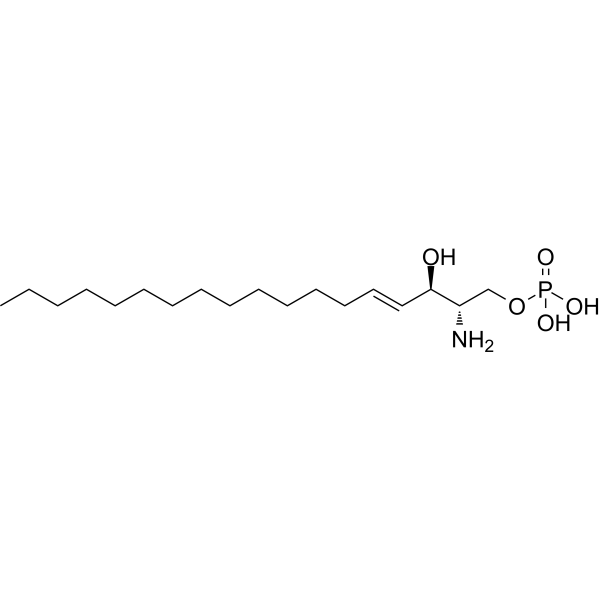| DC29064 |
Ubiquinol |
Ubiquinol (Ubiquinol-10) is a reduced form of coenzyme Q10 (CoQ10). Ubiquinol is a potent antioxidant that has the capacity to protect Vitamin E, and also helps to regenerate depleted vitamin E and Vitamin C. Ubiquinol is both lipophilic and hydrophilic and acts as transmembrane factor preventing lipid peroxidation and propagation by transferring electrons to ROS. |

|
| DC29077 |
L-Carnitine hydrochloride
Featured
|
L-Carnitine hydrochloride ((R)-Carnitine hydrochloride), a highly polar, small zwitterion, is an essential co-factor for the mitochondrial β-oxidation pathway. L-Carnitine hydrochloride functions to transport long chain fatty acyl-CoAs into the mitochondria for degradation by β-oxidation. L-Carnitine hydrochloride is an antioxidant. L-Carnitine hydrochloride can ameliorate metabolic imbalances in many inborn errors of metabolism. |

|
| DC29168 |
9-cis-Retinal |
9-cis-Retinal is a natural retinoid. Dietary 9-cis-β-carotene generates 9-cis-retinoids via cleavage into 9-cis-retinal. 9-cis Retinal binds to cellular retinol-binding protein-I (CRBP-I) and CRBP-II with Kds of 8 nM and 5 nM, respectively. 9-cis-Retinal expedites differentiation and maturation of rod photoreceptors in retinal organoids. |

|
| DC29170 |
L-Methionine sulfoxide
Featured
|
L-Methionine sulfoxide (H-Met(O)-OH), a metabolite of Methionine, induces M1/classical macrophage polarization, and modulates oxidative stress and purinergic signaling parameters. |

|
| DC29177 |
Tetradecanedioic acid |
Tetradecanedioic acid is an endogenous metabolite and belongs to the class of organic compounds known as long-chain fatty acids. Tetradecanedioic acid can act as a candidate biomarker for organic anion-transporting polypeptide mediated drug-drug interactions . |

|
| DC29182 |
N-Acetyl-L-glutamic acid
Featured
|
N-Acetyl-L-glutamic acid, a N-acyl-L-amino acid, is a component of animal cell culturing media. N-Acetyl-L-glutamic acid is a metabolite of Saccharomyces cerevisiae and human. |

|
| DC29184 |
L-Dihydroorotic acid |
L-Dihydroorotic acid can reversibly hydrolyze to yield the acyclic L-ureidosuccinic acid by dihydrowhey enzyme. |

|
| DC29191 |
trans-Cinnamaldehyde |
trans-Cinnamaldehyde can be used to prepare highly polyfunctionalized furan ring by reaction of alkyl isocyanides with dialkyl acetylenedicarboxylate. trans-Cinnamaldehyde can be used to synthesize trans-cinnamaldehyde -β-cyclodextrin complex, an antimicrobial edible coating that increases the shelf life of fresh-cut fruits. |

|
| DC40072 |
SY-640 |
SY-640 is an Acetamide derivative and has potent hepatoprotective effect. SY-640 reduces Propionibacterium acnes and Lipopolysaccharide-induced liver injury in mice. |

|
| DC40103 |
Sphingosine-1-phosphate
Featured
|
Sphingosine-1-phosphate (S1P) functions as a versatile signaling molecule, acting both intracellularly and extracellularly. Within cells, it serves as a secondary messenger, playing a key role in calcium ion (Ca²⁺) mobilization. Externally, S1P acts as a ligand, binding to and activating a range of G protein-coupled receptors, including S1P1-5 receptors as well as GPR3, GPR6, and GPR12. This bioactive lipid is synthesized from sphingomyelin and other membrane phospholipids, highlighting its importance as a critical mediator in various cellular processes. |

|
| DC40107 |
C16-PAF |
C16-PAF (PAF (C16)), a phospholipid mediator, is a platelet-activating factor and ligand for PAF G-protein-coupled receptor (PAFR). C16-PAF exhibits anti-apoptotic effect and inhibits caspase-dependent death by activating the PAFR. C16-PAF induces increased vascular permeability. |

|
| DC40151 |
Lumisterol 3 (>90%) |
Lumisterol 3 (>90%) (9β,10α-Cholesta-5,7-dien-3β-ol) is a normal human secosterooid metabolite from the class of vitamin D3 photoisomer derivatives. Lumisterol 3 (>90%) is used in the preparation of vitamin D. |

|
| DC40159 |
L-Sepiapterin |
L-Sepiapterin (Sepiapterin) is a precursor of the endothelial nitric oxide synthase (eNOS) cofactor tetrahydrobiopterin (BH4). L-Sepiapterin improves endothelial dysfunction in small mesenteric arteries from db/db mice, and induces angiogenesis. L-Sepiapterin inhibits cell proliferation and migration of ovarian cancer cells via down-regulation of p70S6K-dependent VEGFR-2 expression. |

|
| DC40165 |
(±)8-HETE |
(±)8-HETE is one of the six monohydroxy fatty acids produced by the non-enzymatic oxidation of arachidonic acid. The biological activity of (±)8-HETE is likely to resemble that of its constituent enantiomers (8(R)-HETE and 8(S)-HETE).
|

|
| DC40176 |
3α,7α-Dihydroxycoprostanic acid |
3α,7α-Dihydroxycoprostanic acid is an endogenous metabolite. 3α,7α-Dihydroxycoprostanic acid, a bile acid, is the precursor to chenodeoxycholic acid. |

|
| DC40177 |
sn-Glycerol 3-phosphate biscyclohexylammonium salt |
sn-Glycerol 3-phosphate biscyclohexylammonium salt is produced by cytosolic glycerol 3-phosphate dehydrogenase pathway through the reduction of dihydroxyacetone phosphate using NADH formed during glycolysis. |

|
| DC40178 |
Isobutyryl-L-carnitine chloride |
Isobutyryl-L-carnitine chloride is a product of the acyl-CoA dehydrogenases. |

|
| DC40179 |
8-Isoprostaglandin F2α |
8-Isoprostaglandin F2α is an isoprostane produced by the non-enzymatic peroxidation of arachidonic acid in membrane phospholipids. 8-Isoprostaglandin F2α is present in human plasma in two distinct forms - esterified in phospholipids and as the free acid. 8-Isoprostaglandin F2α is a weak TP receptor agonist in vascular smooth muscle. |

|
| DC40180 |
Diadenosine pentaphosphate pentasodium |
Diadenosine pentaphosphate pentasodium is an endogenous vasoactive purine dinucleotide which has been isolated from thrombocytes. Diadenosine polyphosphates (ApnA, n=2–7) have been identified as constituents of secretory vesicles such as in platelets, chromaffin cells, Torpedo synaptic terminals and brain synaptosomes. |

|
| DC40181 |
Diadenosine pentaphosphate pentaammonium |
Diadenosine pentaphosphate pentaammonium is an endogenous vasoactive purine dinucleotide which has been isolated from thrombocytes. Diadenosine polyphosphates (ApnA, n=2–7) have been identified as constituents of secretory vesicles such as in platelets, chromaffin cells, Torpedo synaptic terminals and brain synaptosomes. |

|
| DC40182 |
Diadenosine pentaphosphate pentalithium |
Diadenosine pentaphosphate pentalithium is an endogenous vasoactive purine dinucleotide which has been isolated from thrombocytes. Diadenosine polyphosphates (ApnA, n=2–7) have been identified as constituents of secretory vesicles such as in platelets, chromaffin cells, Torpedo synaptic terminals and brain synaptosomes. |

|
| DC40183 |
Succinyladenosine |
Succinyladenosine, the metabolic product of dephosphorylation of intracellular adenylosuccinic acid (S-AMP) by cytosolic 5-nucleotidase, is a biochemical marker of adenylosuccinase (ASL) deficiency. |

|
| DC40187 |
2-Furoylglycine |
2-Furoylglycine, a urinary metabolite in human, is a putative biomarker for coffee consumption. |

|
| DC40188 |
11β-Hydroxyandrosterone |
11β-Hydroxyandrosterone is a 11-oxygenated androgen metabolite of 11β-hydroxyandrostenedione. |

|
| DC40190 |
L-Glyceric acid |
L-Glyceric acid is a mainly urinary metabolite accumulating in rare inherited metabolic disease L-glyceric aciduria. L-Glyceric acid can be used to diagnose primary hyperoxaluria type 2 (PH2). L-Glyceric acid excretion to distinguish PH1 from PH2. |

|
| DC40191 |
L-Glyceric acid sodium |
L-Glyceric acid sodium is a mainly urinary metabolite accumulating in rare inherited metabolic disease L-glyceric aciduria. L-Glyceric acid sodium can be used to diagnose primary hyperoxaluria type 2 (PH2). L-Glyceric acid sodium excretion to distinguish PH1 from PH2. |

|
| DC40192 |
Leukotriene C4 |
Leukotriene C4 is the parent cysteinyl leukotriene produced by the LTC4 synthase catalyzed conjugation of glutathione to LTA4. Leukotriene C4 is produced by neutrophils, macrophages, mast cells, and by transcellular metabolism in platelets. Leukotriene C4 is one of the constituents of slow-reacting substance of anaphylaxis (SRS-A) and exhibits potent smooth muscle contracting activity. |

|
| DC40195 |
11-Oxo etiocholanolone |
11-Oxo etiocholanolone (11-Ketoetiocholanolone) is a metabolite of Etiocholanolone. Etiocholanolone is the excreted metabolite of testosterone and has anticonvulsant activity. |

|
| DC40199 |
Acetyl Coenzyme A trisodium |
Acetyl Coenzyme A trisodium (Acetyl-CoA trisodium) is a central metabolic intermediate. Acetyl Coenzyme A trisodium is the actual molecule through which glycolytic pyruvate enters the tricarboxylic acid (TCA) cycle, is a key precursor of lipid synthesis, and is the sole donor of the acetyl groups for acetylation. Acetyl Coenzyme A trisodium acts as a potent allosteric activator of pyruvate carboxylase (PC). |

|
| DC40254 |
γ-Globulins from human blood |
γ-Globulins from human blood are a class of proteins in the blood. γ-Globulin is a protein fraction of blood serum containing many antibodies that protect against bacterial and viral infectious diseases. γ-Globulins from human blood is used for common variable immunodeficiency |

|





























